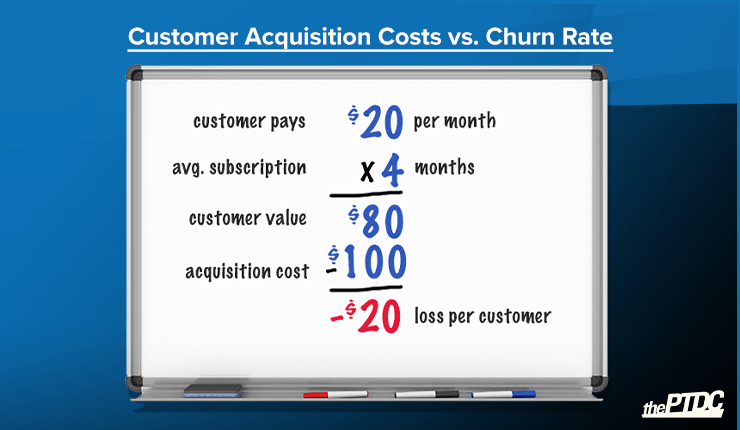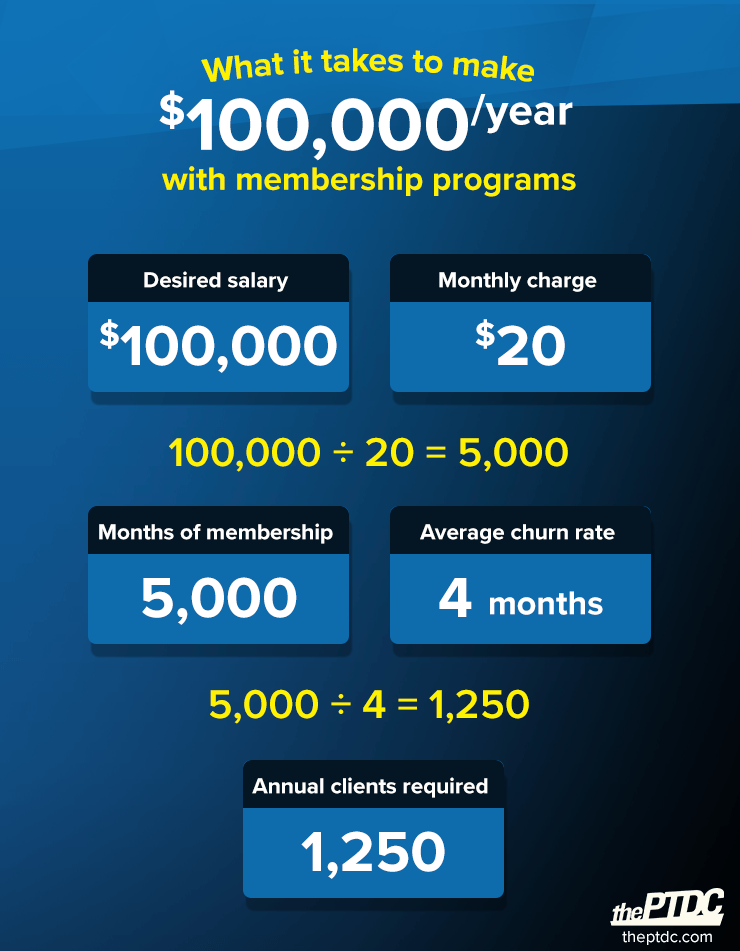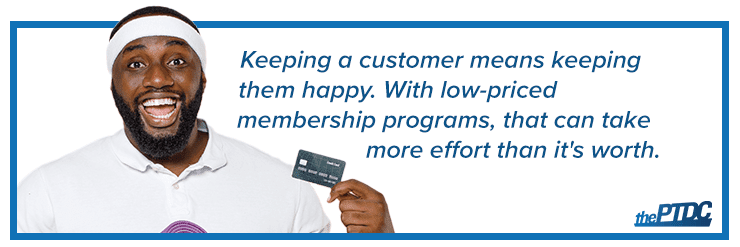Membership platforms sound like a great deal for personal trainers. Steady income, minimal effort—what’s not to like?
You’ve probably heard about them. For a monthly fee—usually $20 to $40—your members get a new workout every month, exclusive content you create for them, and access to you in a members-only community.
I get the appeal. Do work once, deliver it to many, get paid over and over again.
Unfortunately, when you consider the true economics of a membership site, they’re almost always an absolutely horrible idea for just about every fitness professional.
By the end of this short article, you’ll agree.
And, more importantly, you’ll know a better way to grow your business to make more, work smarter, and, ultimately, have more freedom.
Why the appeal of a membership program tricks personal trainers
Which of these two things looks better?
- Sell a membership program for $20 a month to a lot of people.
- Sell online personal training for $200 or $300 a month to a few people.
On the surface, the cheaper option looks like it would be way better.
If you can get 200 people to sign up for your membership program, that’s $4,000 a month, $48,000 a year. And you’ll have plenty of time left over to train clients, travel, be with family, or volunteer.
Not only that, signing people up for less money should be easy, right?
Wrong.
Here’s what actually happens:
Most members will quit within the first few months

No one joins a membership program with the intent of staying indefinitely.
Most people who join a membership program do so with the intent on cancelling before the end of the first month.
In the best-run programs, the churn rate (how quickly somebody cancels) is four to six months.
Translation: That calculation you’re doing in your head about how much money you’ll make year after year with your customers is invalid.
Your members won’t stay anywhere close to that long. Which means that you’re going to have to figure out a way to continually attract a ton of new members.
Customer acquisition costs will rise quickly
If you’re popular, or if you haven’t sold anything before, you may be able to get enough early sign-ups from your most loyal followers.
But once you tap that out, which will happen quickly, you’ll find it’s really expensive to find new members.
In the fitness industry, customer acquisition costs can easily climb above $100 per new customer.
And that $100 cost for acquiring a customer assumes you’re an exceptionally skilled marketer who has a strong client conversion system in place, which includes:
- Strong market positioning
- Paid advertising skill
- Great copywriting
- Continual targeted content production
All those things require not just an advanced skill set, but also a full team, which won’t be cheap.
With this in mind, do some quick math:

$100 to acquire a new customer who pays $20 and stays for four months (if you do a good job) = a loss of $20 per customer.
Not exactly “working less for more money,” is it?
And this doesn’t take into account any staffing costs, payment processing fees, taxes, or a plethora of other expenses.
The exception is if you’re a celebrity with a huge platform that’s growing fast enough organically to bring in a steady stream of new members. If that’s you, then a membership site as a low-end offer, one that’s designed to funnel people into higher-ticket programs, might be a good addition to your product suite.
Retention and turnover are huge obstacles
If you charge $20 and pay $100 to acquire each new member, you need them to stay in the program at least five months just to break even.
As we’ve already discussed, this is on the very high end for retention. Sure, some members might stay forever, but you have to average it out.
Not only that, your first members will be the people who are most engaged with you, which means they’ll stay the longest. Customers you acquire later typically churn faster because they were acquired through more conventional marketing channels, including paid ads. They have no established connection to you or your audience.
To get anywhere close to this level of retention, you need an incredible onboarding process at the front end, and enough new content and personal interaction to keep them engaged long enough for you to make a profit from their membership.
It’s certainly possible to build these systems into a membership site. But, like everything else, it’s difficult, takes a lot of time, and requires a lot of skills you may not have when you launch the site.
Not only that, keeping them happy and engaged is much harder than you expect, because …
Customers who pay the least are the hardest to please
I first learned this as a personal trainer, when people who got complimentary memberships were most likely to complain about things like the quality of the towels.
Meanwhile, the people who spent thousands of dollars a month to work one-on-one with our trainers would just bring their own towels if they didn’t like ours.
It’s a truism of any business: People who pay less demand more. In building a low-end membership site you’re self-selecting for customers who are the most annoying to deal with.
Your best customers are the ones who pay the most money. They treat you with the same respect they get in their own professional capacity.
Want to make six figures with a membership program? Good luck with that!

Gut check: Why do you actually want to charge less money?
If you get triggered by the following statement, it probably applies to you:
The reason you want to charge less is because you aren’t confident enough to charge more.
Trainers who lack confidence too often tell themselves they “just want to help people,” using their good intentions as an excuse to charge less than their services are worth.
Imposter syndrome is real and it leads a lot of good trainers into a bad business model.
What I learned from the three membership programs I launched that generated millions of $$ in sales … and closed
The first one I launched was the PTDC Inner Circle. It was $10 a month, or $5 if you paid for a year in advance. For that they got a new webinar every month.
We had 700 members at the peak, but I shut it down because I didn’t think it added much value.
In its place I started the Professional Trainer Society, a full-blown membership site with forums and exclusive content. We charged $20 to $30 a month and had more than 1,400 members before we launched.
Sounds like a huge success, right? We were making tens of thousands of dollars a month right from the jump and producing what I thought was incredible material for our members.
And yet, I quickly got frustrated.
The people paying for access to our stellar content weren’t using it. And we couldn’t offer it to the rest of our audience because, by definition, the exclusivity of the content was what members were paying for.
So I shut it down.
The last one I launched was Fitness Marketing Monthly, our print-only newsletter. We mailed our first issue to 1,615 subscribers paying $39.95 a month. The post-launch price was $59.95 a month.
FMM was a seven-figure business, with a very healthy 34 percent profit margin. It even got the attention of Entrepreneur magazine, which published a full-page article on it in their June 2019 issue.
But we shut it down after 10 issues.
The biggest problem, which caught me by surprise, is that the people paying us all that money simply weren’t ready to use the high-quality content we produced. They were much closer to the starting line than we had anticipated, and in many cases were better served by the free content we have at the PTDC.
We also had the same problem we’d faced with the Professional Trainer Society. We put everything we had into the content, but we couldn’t use it in other parts of the business because we’d promised exclusivity.
So that’s three different membership programs, two of them on a big scale, all of them profitable.
In their place, we refocused our efforts on the Online Trainer Academy. The payoff as a result of this renewed focus has been a 150 percent growth in revenue and 10 percent profit growth.
Four better ways than membership sites for personal trainers to make more and have more freedom

Fortunately, there are much better business models.
1. Hire another trainer (or two)
If you have more demand than you can personally satisfy, hire a coach. You can increase the number of clients your business serves, increasing revenue without adding to your workload.
And if you need to advertise for clients to fill your new coach’s schedule, the customer acquisition cost will be about the same $100 a month you would’ve spent to bring in new people to a membership program.
The clients you bring in will not only pay more, they’ll treat you and your associate coaches with more respect.
2. Hire someone to handle sales and/or marketing
You didn’t get into coaching with the goal of spending most of your time on sales and marketing.
Imagine how much more effective you’d be if you could bring in one or more professionals to handle those specialized jobs.
By the way, these first two strategies aren’t mutually exclusive.
A good marketing person can help you target more prospects, while a good salesperson can help you convert those clients into prospects.
And if they’re really good, you may need to hire more than one coach to help you handle the influx of new clients.
3. Offer a new service
For example, if you want to charge more by adding a nutrition component to your packages, simply outsource that component to another company that specializes in it, and pocket the difference as additional bottom-line profit.
Combining nutrition coaching with fitness training allows you to charge more. And you don’t even need to provide this service yourself.
4. Write an ebook
A $20 ebook gives people who follow you on social media a low-cost introduction to your training and nutrition philosophy.
Once they’ve purchased your book, you can offer your training services as an upsell.
Selling a book doesn’t come with any expectation of service. It’s 100 percent passive. While the amount of money you’ll make per customer won’t be anywhere close to what you’ll make with online training, it’ll give you a low-end option with a low barrier to entry that can double as a marketing tool into your higher-end services.
Don’t yet have a higher-end program or know how to deliver stellar online coaching? You really need the Online Trainer Academy.












